- Homepage
- Blogs
How Much Does It Cost to Build a Performing Arts Theater?
Leading provider of performing arts theater construction services.
Building a performing arts theater typically costs between $10,550,000 and $22,300,000, translating to $350 to $740 per square foot for a 30,000 sq ft facility. This total cost includes construction, materials, specialized lighting and sound systems, seating, stage equipment, and finishes. Lower-end costs cover basic designs with standard materials, while higher-end costs involve premium materials, advanced technology, custom designs, and additional features like acoustic treatments and VIP areas. Factors influencing the cost per square foot include the complexity of the design, quality of materials, local labor rates, and specific performance requirements. Proper planning and budgeting for unforeseen expenses are essential to keep the project within the estimated cost range.
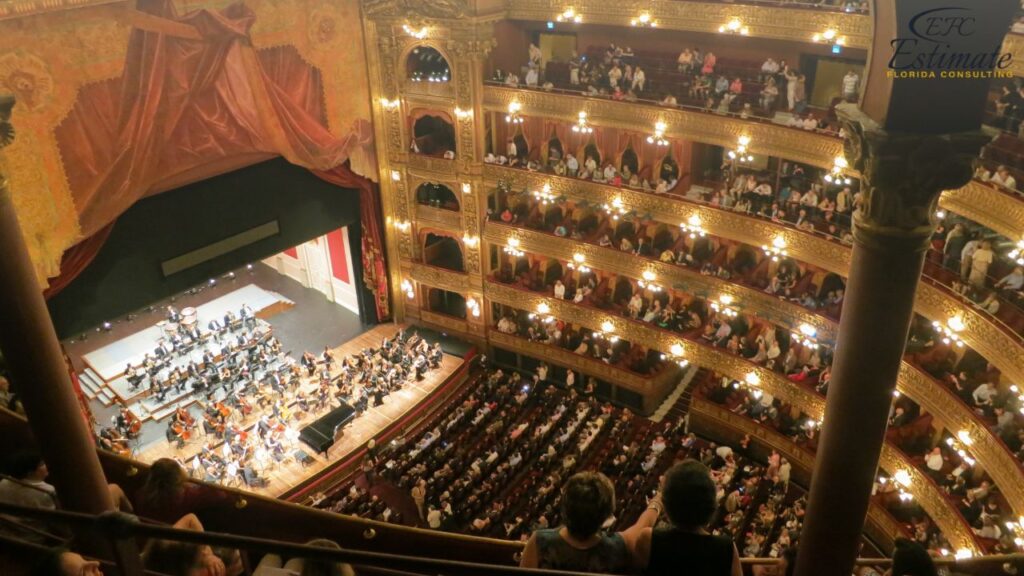
Cost Breakdown for Building a Performing Arts Theater
Site Preparation
Site preparation includes land acquisition, clearing, grading, and any necessary site improvements such as utilities and access roads. These costs can vary based on the location and condition of the land. Proper site preparation is essential to ensure a stable foundation and smooth construction process.
Component | Estimated Cost (in dollars) |
Land Acquisition | $200,000 – $1,000,000 |
Site Clearing and Grading | $50,000 – $150,000 |
Utilities and Infrastructure | $100,000 – $300,000 |
Construction
Construction costs cover the main building structure, including the foundation, walls, roof, and interior finishes. This category also includes labor costs, permits, and inspections. The complexity and design of the theater will influence these costs.
Component | Estimated Cost per Sq Ft (in dollars) | Total Cost for 30,000 Sq Ft Theater (in dollars) |
Foundation and Structure | $100 – $200 | $3,000,000 – $6,000,000 |
Roofing and Exterior | $50 – $100 | $1,500,000 – $3,000,000 |
Interior Finishes | $75 – $150 | $2,250,000 – $4,500,000 |
Labor | $50 – $100 | $1,500,000 – $3,000,000 |
Permits and Inspections | $50,000 – $150,000 | $50,000 – $150,000 |
Technology and Equipment
Technology and equipment costs include lighting, sound, staging, and other technical systems necessary for performances. Investing in high-quality equipment ensures the theater can host a wide range of events.
Component | Estimated Cost (in dollars) |
Lighting Systems | $300,000 – $600,000 |
Sound Systems | $200,000 – $500,000 |
Staging Equipment | $150,000 – $300,000 |
Projection and AV Equipment | $100,000 – $250,000 |
90% More Chances to Win Projects With Our Estimate!
- Multi-Family Building
- Hotel Building
- Hospital Building
- Warehouse Building
- School & University Building
- High-Rise Building
- Shopping Complex
- Data Center Building
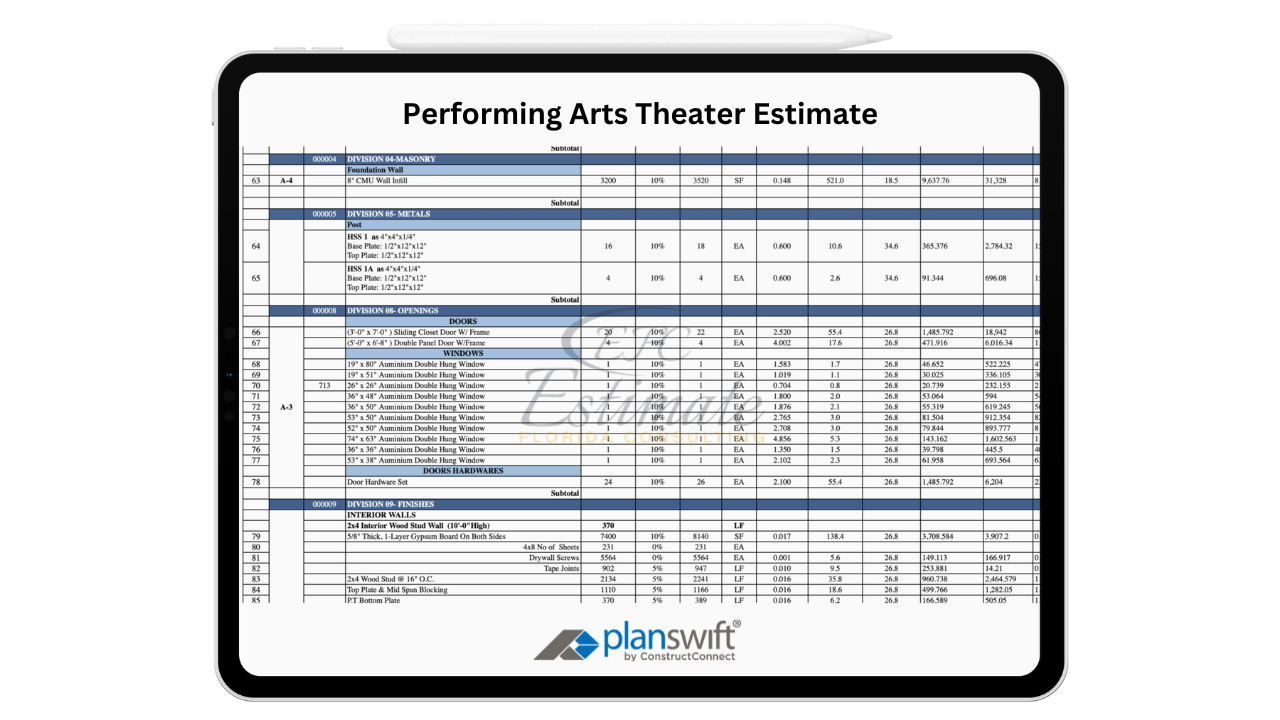
Additional Facilities and Amenities
Additional facilities such as rehearsal spaces, dressing rooms, administrative offices, and concessions areas add to the overall cost. These spaces enhance the functionality and user experience of the theater.
Component | Estimated Cost (in dollars) |
Rehearsal Spaces | $100,000 – $300,000 |
Dressing Rooms | $50,000 – $150,000 |
Administrative Offices | $150,000 – $300,000 |
Concessions and Lobby Areas | $200,000 – $500,000 |
Contingency and Miscellaneous Costs
A contingency fund covers unexpected expenses and changes during the construction process. Miscellaneous costs may include insurance, legal fees, and marketing for the grand opening.
Component | Estimated Cost (in dollars) |
Contingency Fund | $500,000 – $1,000,000 |
Insurance and Legal Fees | $100,000 – $200,000 |
Marketing and Promotion | $50,000 – $100,000 |
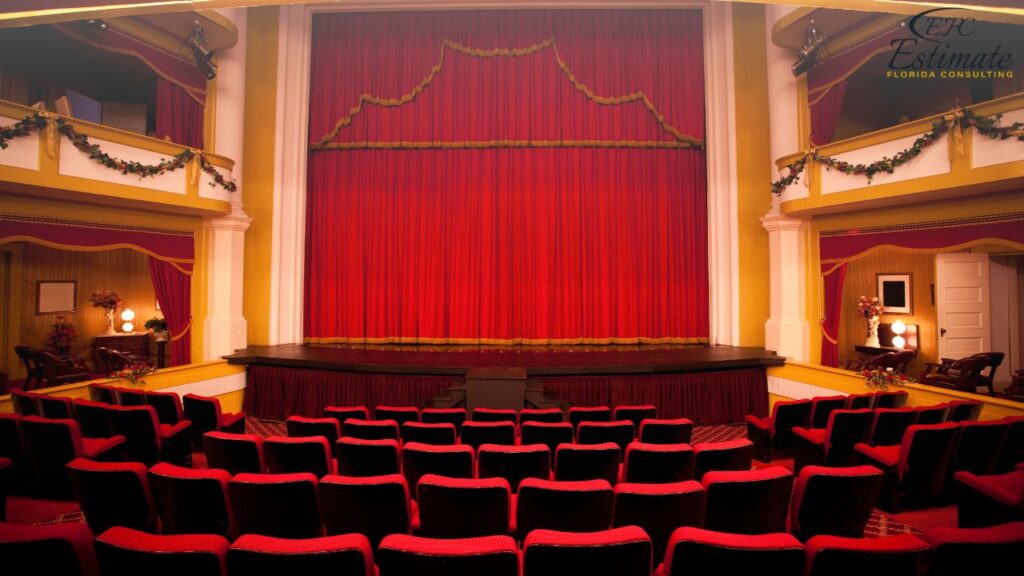
A contingency fund is essential to cover any unexpected costs that may arise during construction. This could include unforeseen site issues, design changes, or material price increases. Insurance and legal fees ensure that the project complies with all regulations and is protected against potential liabilities. Marketing and promotion are crucial for generating interest and attendance for the theater’s opening and ongoing operations.
We Provide 3D Rendering Services!
For Performing Arts Theater and Other Projects
Turnaround time is 1-2 days.
Win More Projects With Us
Additional Costs and Considerations
Furniture and Fixtures
Furniture and fixtures are essential for creating a comfortable and functional environment. This includes seating, office furniture, and lobby decor.
Component | Estimated Cost (in dollars) |
Seating | $200,000 – $400,000 |
Office Furniture | $50,000 – $100,000 |
Lobby Decor | $30,000 – $70,000 |
Maintenance and Operations
Ongoing maintenance and operational costs are important to consider. This includes utilities, staffing, and routine maintenance.
Component | Estimated Annual Cost (in dollars) |
Utilities | $100,000 – $200,000 |
Staffing | $200,000 – $500,000 |
Maintenance | $50,000 – $100,000 |
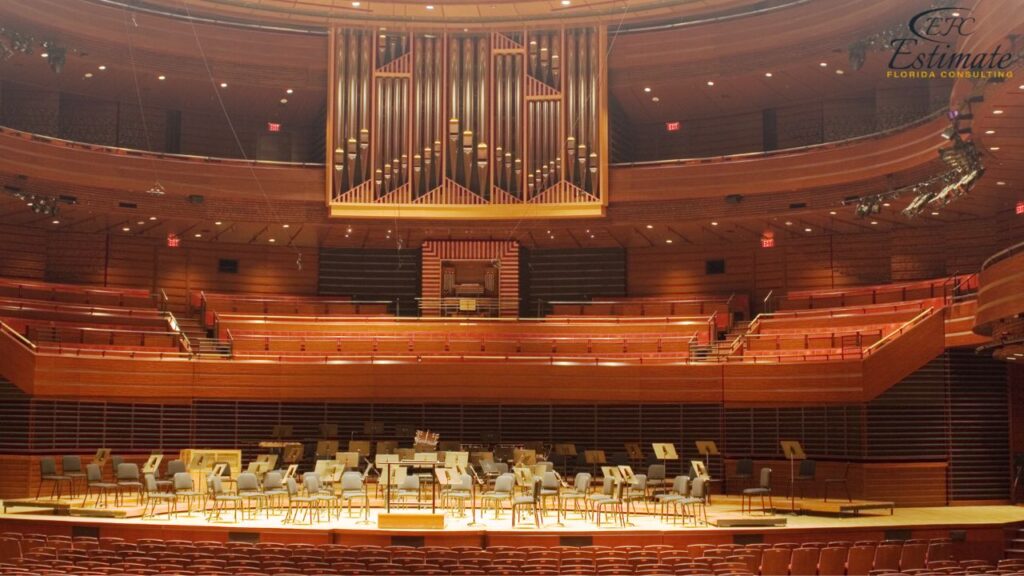
Fundraising and Sponsorship
To cover the high costs of building and maintaining a theater, fundraising and sponsorship efforts are often necessary. This can include grants, donations, and corporate sponsorships.
Component | Estimated Fundraising Goal (in dollars) |
Grants and Donations | $1,000,000 – $5,000,000 |
Corporate Sponsorship | $500,000 – $2,000,000 |
Factors Affecting Construction Costs
Size and Capacity
The size and seating capacity of the theater significantly impact the overall construction cost. Larger theaters with higher seating capacities require more extensive construction, more materials, and larger support facilities such as lobbies, restrooms, and concession areas. The design must also consider acoustics, sightlines, and audience comfort to ensure a high-quality experience. Larger theaters may also necessitate additional exits, accessibility features, and safety measures to comply with building codes and regulations. Furthermore, the scale of the theater can influence the complexity of the structural design and the need for advanced engineering solutions. A well-designed theater can enhance the audience experience, making performances more enjoyable and memorable.
90% More Chances to Win Performing Arts Theater Bids with Our Estimate!
Location
The design and quality of materials used in construction play a crucial role in determining the overall cost. High-end finishes, custom architectural features, and state-of-the-art technology for lighting, sound, and staging can increase expenses. Sustainable and energy-efficient building practices may also add to the initial cost but can result in long-term savings and environmental benefits. Investing in durable, high-quality materials can reduce maintenance and repair costs over time. Moreover, the aesthetic appeal and functionality of the design can influence the theater’s ability to attract audiences and events, impacting its revenue potential. A visually appealing and well-designed theater can also enhance its reputation and prestige, attracting high-profile performers and productions.
Facilities and Amenities
The inclusion of additional facilities and amenities such as rehearsal spaces, dressing rooms, administrative offices, and backstage areas can impact the cost. The quality and quantity of these features should align with the theater’s intended use and target audience. Investing in modern amenities enhances the functionality and attractiveness of the theater. Comprehensive facilities can support a wider range of productions and events, increasing the theater’s versatility and appeal. Additionally, providing comfortable and well-equipped spaces for performers and staff can enhance their experience and contribute to the overall success of productions. The availability of such amenities can also make the theater a preferred venue for touring companies and special events.
Technology and Equipment
Modern performing arts theaters require advanced lighting, sound, and staging equipment to provide high-quality performances. The cost of these systems can vary widely based on the complexity and specifications. Investing in cutting-edge technology ensures that the theater can host a wide range of performances and meet the technical requirements of different productions. High-quality equipment can enhance the audience’s experience, making performances more engaging and memorable. Additionally, investing in versatile and upgradable systems can future-proof the theater, allowing it to adapt to emerging trends and technologies in the performing arts industry. Advanced technology can also improve the efficiency and effectiveness of theater operations, from ticketing to backstage management.
Benefits of Building a Performing Arts Theater
Cultural Enrichment
A performing arts theater provides a venue for cultural events, such as plays, concerts, dance performances, and other artistic presentations. This enriches the community by offering diverse entertainment options and fostering an appreciation for the arts. The theater can become a cultural landmark, hosting local, national, and international acts, thus enhancing the community’s cultural landscape. Regular performances and events can also stimulate interest in the arts, encouraging local talent and providing opportunities for cultural exchange. Furthermore, the presence of a performing arts theater can inspire educational programs and collaborations with schools and universities, further embedding cultural appreciation within the community.
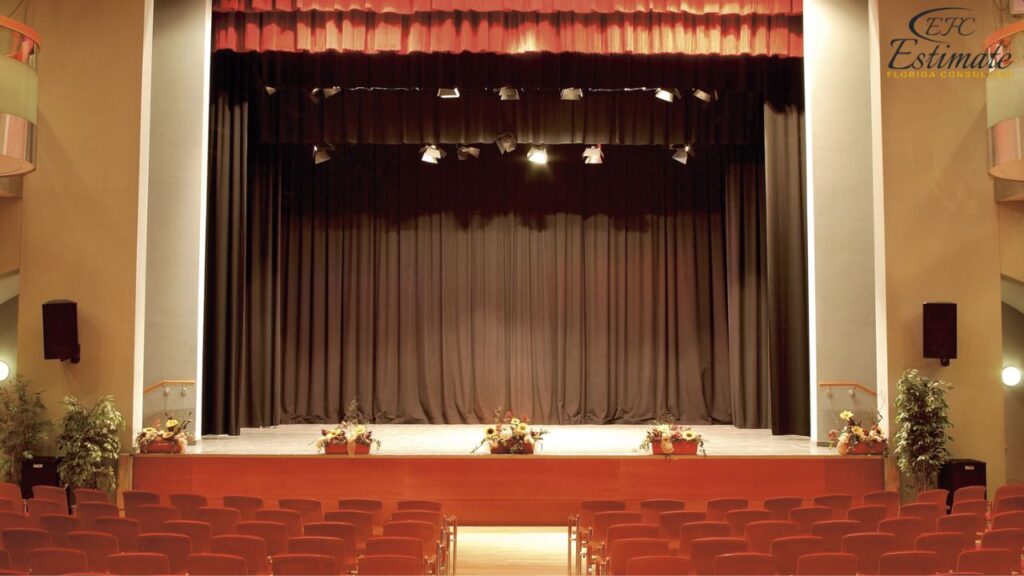
This cultural vibrancy can also enhance the quality of life, making the area more attractive to residents and businesses.
Economic Impact
The construction and operation of a performing arts theater can stimulate the local economy. It creates jobs during the construction phase and ongoing employment opportunities for theater staff, performers, and support services. Additionally, theaters attract visitors, which benefits local businesses such as restaurants, hotels, and retail shops. Hosting large events can draw audiences from surrounding areas, boosting tourism and related economic activities. The economic ripple effect can extend to increased demand for local artisans, catering services, and transportation providers. Additionally, a successful theater can attract investors and sponsors, further enhancing its economic contribution to the area. This influx of economic activity can help revitalize downtown areas and contribute to urban development.
Community Engagement
A performing arts theater serves as a community hub, bringing people together for shared experiences. It can host community events, educational programs, and workshops, promoting social interaction and engagement. By providing a space for local artists and organizations to showcase their work, the theater fosters a sense of pride and ownership within the community. This engagement can lead to the formation of partnerships and collaborations between different community groups, enhancing social cohesion. Furthermore, the theater can be a venue for civic meetings, public forums, and other community-centric activities, strengthening its role as a vital community asset. Regular community involvement can also create a loyal patron base, ensuring the theater’s sustainability.
Get 5 New Projects in the Next 7 Days With Our System
Educational Opportunities
Theater spaces can be used for educational purposes, offering workshops, classes, and youth programs that nurture artistic talents and skills. Partnerships with schools and educational institutions can provide students with unique learning experiences in the performing arts. These educational initiatives can inspire the next generation of artists and cultivate a lifelong appreciation for the arts. Students can benefit from hands-on learning opportunities, mentorship programs, and exposure to professional performances, all of which can enrich their educational journey. Additionally, the theater can serve as a practical learning environment for students pursuing careers in theater production, stage management, and other related fields. This educational aspect can also open doors for internships and apprenticeships, providing real-world experience.
Conclusion
Building a performing arts theater is a substantial investment that can provide numerous benefits, including cultural enrichment, economic impact, community engagement, and educational opportunities. By understanding the various costs involved, including site preparation, construction, technology and equipment, additional facilities, and contingency funds, you can effectively plan and budget for your project. Proper planning and budgeting are crucial to ensuring a successful construction project that meets the needs of the community and provides a versatile, high-quality venue for the performing arts. Investing in a performing arts theater not only enhances the cultural fabric of the community but also supports the growth and development of the arts, providing a lasting legacy for future generations.
Question Answer
Frequently Asked Question
The cost of building a performing arts theater typically ranges from $10,550,000 to $22,300,000. This translates to approximately $350 to $740 per square foot for a 30,000 sq ft facility.
Factors affecting the cost per square foot include the complexity of the design, quality of materials used, local labor rates, and specific performance requirements such as acoustics and lighting.
The total cost includes construction, materials, specialized lighting and sound systems, seating, stage equipment, and finishes. Additional facilities like rehearsal spaces, dressing rooms, administrative offices, and concessions areas are also part of the cost.
Site preparation costs can vary based on location and land condition. They typically include:
- Land Acquisition: $200,000 - $1,000,000
- Site Clearing and Grading: $50,000 - $150,000
- Utilities and Infrastructure: $100,000 - $300,000
Construction costs cover the main building structure and include labor, permits, and inspections. For a 30,000 sq ft theater, the estimated costs are:
- Foundation and Structure: $3,000,000 - $6,000,000
- Roofing and Exterior: $1,500,000 - $3,000,000
- Interior Finishes: $2,250,000 - $4,500,000
- Labor: $1,500,000 - $3,000,000
- Permits and Inspections: $50,000 - $150,000
Technology and equipment are crucial for performances. Estimated costs include:
- Lighting Systems: $300,000 - $600,000
- Sound Systems: $200,000 - $500,000
- Staging Equipment: $150,000 - $300,000
- Projection and AV Equipment: $100,000 - $250,000

